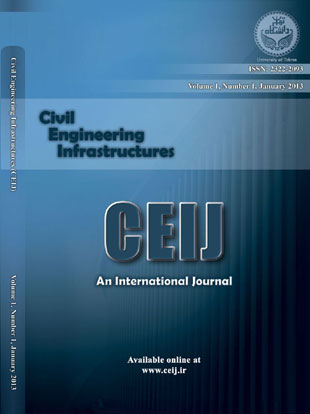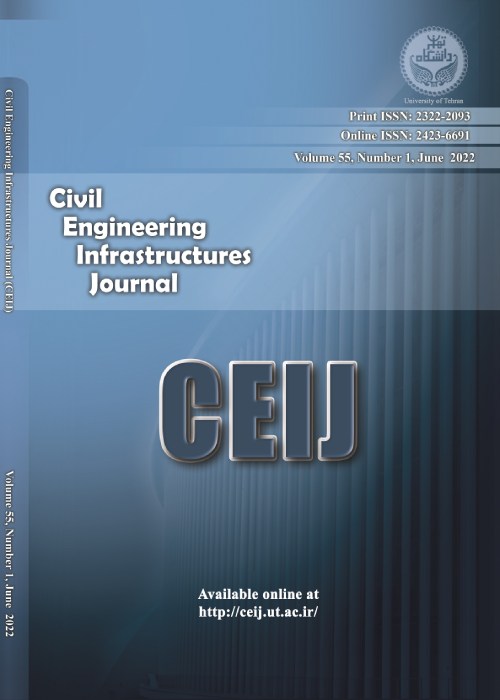فهرست مطالب

Civil Engineering Infrastructures Journal
Volume:46 Issue: 1, Jan 2013
- تاریخ انتشار: 1391/12/23
- تعداد عناوین: 7
-
-
Page 1The dynamic response of a transversely isotropic, linearly elastic layer bonded to the surface of a half-space of a different transversely isotropic material under arbitrary shape surface loads is considered. With the help of displacements and stresses Green’s functions, an analytical formulation is presented for the determination of the displacements and stresses at any point in both surface layer and the underneath half-space in frequency domain. Special results are prepared for circular, ellipsoidal, square and recangular patch load. It is shown that the displacements and stresses due to circular patch load are colapesd on the existing solution in the literature. Some new illustrations are prepared to show the effect of the shape of the patch on the responses of the domain specially near the load.Keywords: Forced Vibration, Layer Medium, Solid Mechanics, Transversely Isotropic, Wave Propagation
-
Page 15The present research is concerned with the determination of ductility, over-strength and response modification factors of coupled steel shear wall frames. Three structural models with various numbers of stories, bay width and coupling beam height were analyzed using static pushover and incremental nonlinear dynamic analyses. The ductility, over-strength and response modification factors for the three models are determined. Tentative values of 11.1, 11.6 and 10.6 are suggested for the response modification factor of coupled steel shear wall frames with deep and medium depth coupling beams, and uncoupled steel shear wall frames, respectively in the allowable stress design method.Keywords: Coupled Steel Shear Walls, Ductility Reduction Factor, Incremental Nonlinear Dynamic Analysis, Over Strength Reduction Factor, Response Modification Factor, Static Pushover Analysis
-
Page 27Finding a suitable estimation of stability domain around stable equilibrium points is an important issue in the study of nonlinear dynamical systems. This paper intends to apply a set of analytical-numerical methods to estimate the region of attraction for autonomous nonlinear systems. In mechanical and structural engineering, autonomous systems could be found in large deformation problems or control of structures. In order to have an appropriate estimation of stability domain, some suitable Lyapunov functions are calculated by satisfying the modified Zubov''s partial differential equation in a finite area around the asymptotically stable equilibrium point. To achieve this, the techniques of Collocation, Galerkin, Least squares, Moments and Sub-domain are applied. Furthermore, a number of numerical examples are solved by the suggested techniques and Zubov''s construction procedure. In most cases, the proposed approaches compared with Zubov’s scheme give a better estimation stability domain.Keywords: Asymptotically Stable, Autonomous Systems, Lyapunov Function, Method of Weighted Residuals, Modified Zubov's PDE, Stability Domain
-
Page 51The National Bridge Stock of Iran consists of about 330,000 bridges, of which around 50% are older than 30 years. Since 2010, Iran Road Maintenance & Transportation Organization has started implementing a comprehensive Bridge Management System in order to manage this aged stock efficiently. To predict future conditions of bridge stock, a heuristic numerical method is presented. This methodology is based on Markovian process to model deterioration of bridge decks and a multi-objective optimization problem to find the best solutions. The optimization problem involves three decision variables regarding management strategies, and has three objectives regarding cost minimization. Constraints of the problem are the percentage of deficient bridges, the percentage of bridges under MR&Rs (Maintenance, Repair and Rehabilitation) and the average value of condition scores. The results show that to avoid future challenges, the annual budget for bridge maintenance should be increased, the current maintenance strategy should be improved as soon as possible, and national manuals and instructions for inspection, condition rating and maintenance should be developed.Keywords: BMS, Bridge Deterioration, Markovian Process, Multi, Objective Optimization, National Bridge Stock of Iran, Strategic Planning
-
Page 69The computation of structural failure probability is vital importance in the reliability analysis and may be carried out on the basis of the first-order reliability method using various mathematical iterative approaches such as Hasofer-Lind and Rackwitz-Fiessler (HL-RF). This method may not converge in complicated problems and nonlinear limit state functions, which usually shows itself in the form of periodic, bifurcation and chaos solution. In this paper, the HL-RF method has been improved based on the relaxed method to overcome these numerical instabilities. An appropriate relaxed coefficient has been defined, ranging between 0 and 1, to enhance the HL-RF method. This coefficient can be computed using the information from the new and previous iterations of the HL-RF algorithm based on second-order fitting. Capability, robustness and efficiency of the proposed algorithm have been studied by results of several examples compared to the HL-RF. Results illustrated that the proposed method is more efficient and robust in the computation of the failure probability compared to the HL-RF method.Keywords: Failure Probability, First, Order Reliability Method, HL, RF Method, Relaxed Method, Reliability Index
-
Page 81The knee bracing steel frame (KBF) is a new type of energy dissipating frame which enjoys exceptional ductility and lateral stiffness. Rather than the beam-column joint, one end of the diagonal brace in KBF is attached to the knee element. Indeed, the knee element as a hysteretic damper is designed and detailed to behave like a structural fuse by sustaining controlled inelastic deformations as well as by dissipating seismic energy, yet other parts and connections remain elastic. Simultaneously, the lower strength steel is utilized in knee element based on the general concept of easy-going steel (EGS). As the current paper takes into account the effect of easy going steel on KBF''s response modification factor, several frames with similar dimensions but varying heights are designed based on the Iranian code of practice. For this purpose, initially the knee elements are substituted with the one made of EGS and subsequently the seismic parameters such as response modification factor and seismic performance levels are compared based on non-linear incremental dynamic analysis (IDA). The average values of response modification factor for these frames have been obtained 11.4 and 11.6 for KO and KE frames respectively. The results reveal that the frames'' stiffness and ductility factor with EGS augments by 10% and 6% respectively.Keywords: Easy, Going Steel (EGS), Increment Dynamic Analysis (IDA), Knee Bracing Steel Frame, Response Modification Factor (R
-
Page 95The momentum equation in the kinematic wave model is a power-law equation with two parameters. These parameters, which relate the discharge to the flow area, are commonly derived using Manning’s equation. In general, the values of these parameters depend on the flow depth except for some special cross sections. In this paper, improved estimates of the kinematic wave parameters for circular channels were developed using the kinematic sensitivity indicator. Using this indicator, the parameters were mathematically derived nearly independent of the flow depth for two cases: constant and variable Manning’s roughness coefficients. The proposed parameters were estimated for a practical range of water depth levels and were verified using an approximate method. The results showed that the proposed parameters are more accurate than existing parameters in estimating the discharge for circular channels. The proposed parameters also improved the estimate of travel time in circular channels, which is of significant importance in drainage design.Keywords: Circular Channels, Drainage Design, Flow Depth, Independent Parameters, Kinematic Wave Modeling, Power Law Equation, Travel Time


